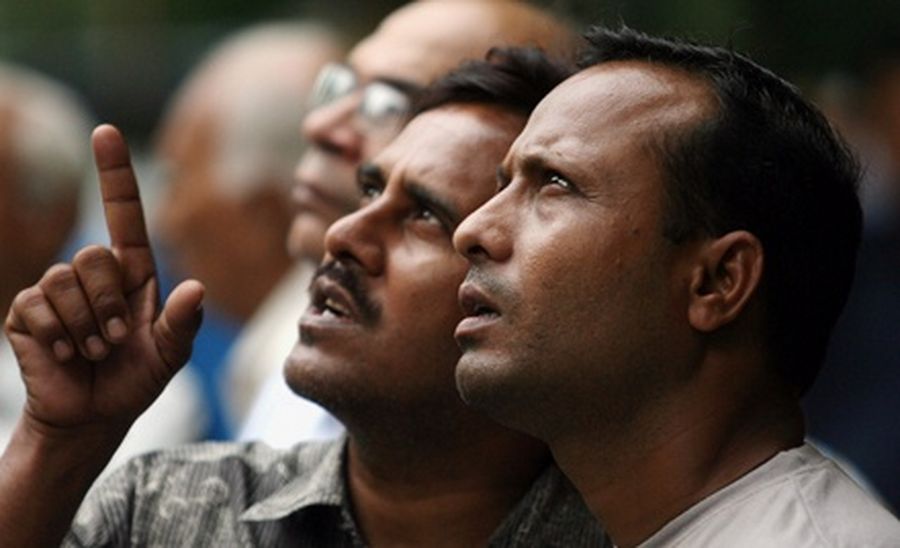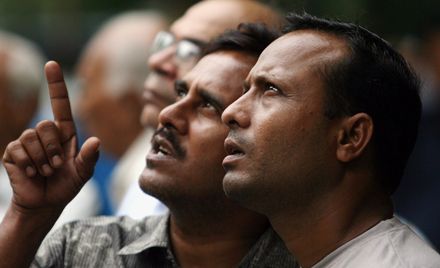Reliance Industries has kept financiers on their toes with a smart and consistent strategy, despite India’s troubled economy and highly volatile markets.

Source: REUTERS/Arko Datta
People look at a large screen displaying India’s benchmark share index on the facade of the BSE building in Mumbai.
Reliance Industries is one of the most sought-after and savviest borrowers in Asia for a reason. Whether the market is raining deals or in a shutdown, Reliance goes about its business of raising funds in a methodical and meticulous manner.
In the past 12 months Reliance has successfully raised more than US$5bn through loans and bonds amid challenging market conditions for Indian credits. Often, where other borrowers find it hard to get traction, Reliance has easily attracted lenders and investors to its transactions.
The best example is the recently concluded US$1.75bn dual-tranche loan signed earlier this month. When the deal first emerged in late July as the borrower sent out a request for proposals, few, including Reliance, would have anticipated the rocky road ahead.
In mid-August, the Indian rupee went into freefall and flirted with all-time lows before regaining ground a month later. The ensuing mayhem caused jitters among global investors and lenders as financiers shunned India Inc.
Reliance, of course, went about putting together the arranger group for the loan as it had always done, roping in 19 banks – the most it has mandated for its loan market borrowings and proof of its relationship pull.
“We nurture long-term relationships with several international and Indian banks with a view to match their strengths with our needs,” said Vineyesh Sawhney, senior vice president, finance at Reliance.
The large number of banks in the arranger group is nothing new for Reliance. However, it has included more banks at the top this time in a reflection of the current market conditions.
“The game has changed. Previously, Reliance would bring together 12–15 banks to form the arranger group on its loans. On the latest deal, it has brought in 19 banks in a reflection of the current market conditions, as well as the fact that some lenders have elevated their relationships with the borrower,” said a loan syndications banker in Hong Kong.
While this move expanded Reliance’s core group of lenders, it diminished liquidity in the retail syndication market. Nonetheless, despite negative sentiment among foreign lenders, Reliance still managed to attract banks to its deal, including commitments from Taiwanese lenders, which had exhausted their country limits for Indian credits.
The US$1.75bn loan drew US$50m combined from four Taiwanese banks. While it pales in comparison with Reliance’s previous borrowings, in the context of the near-absence of Taiwanese lenders on other loans from India this year, the response was commendable. Loan market conditions have not necessarily been healthy for syndicated deals from India.
Moreover, pricing on this latest loan is not the most generous among the deals in the market and yet it features 30 lenders in total. The loan pays all-in pricing of 170bp on the US$1.2bn five-year portion and 186bp on the US$500m six-year part.
The outcome on the latest loan is a tad better in terms of number of lenders than Reliance’s previous syndicated facility signed in September 2012. That US$1.5bn-equivalent dual-tranche loan had 28 banks participating and paid top-level all-ins of 245bp and 265bp on the US$1bn 5.5-year average-life tranche A and the US$500m 6.75-year average-life tranche B, respectively.
Interestingly enough, even as the majority of India Inc sits on the sidelines, refraining from capital expenditures, Reliance appears to be the lone ranger to raise funds offshore for its capex plans.
“We have increased up our borrowing programme in the last 12 to 18 months. We are currently in the midst of our largest investment cycle,” said Sawhney.
The latest loan caps Reliance’s borrowings, which included a US$800m fixed-for-life senior perpetual note in late-January. It is the first and only dollar bond from an Indian issuer without a final maturity.
Reliance appeared to offer the perp with impeccable timing. The security was priced to yield 5.875%, the lowest coupon for the structure. The bonds traded lower in the aftermarket, however.
Another source of funding that Reliance has cultivated well is export credit agencies. In 2013 it has raised nearly US$3bn of long-tenor financings from ECAs of different countries.
In January, it signed a US$1bn direct loan from the Export-Import Bank of the US (US Exim), which also provided a guarantee on a like-sized loan from JP Morgan to the Indian company. In subsequent months, it concluded ECA financings of US$400m from Korea Trade Insurance Corp (March), US$200m-equivalent from Coface (September) and US$300m from UK Export Finance (October), which is the operating name of the Export Credits Guarantee Department.
“We are one of the largest export credit agency-backed borrowers in the world. We deal with around 10–12 ECAs internationally,” added Sawhney.
The fundraisings across loans and bond markets in the past year prove Reliance’s adroit ability to keep investors and lenders on its side even among the most challenging conditions.
To see the digital version of this report, please click here.
